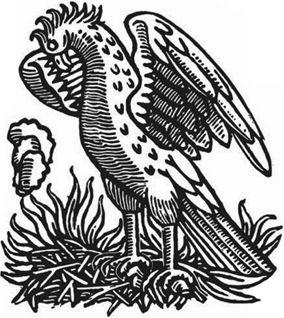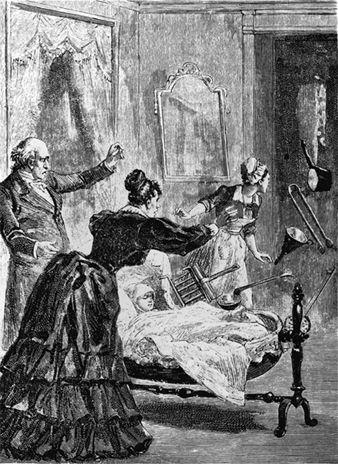The Sorcerer's Companion: A Guide to the Magical World of Harry Potter (60 page)
Read The Sorcerer's Companion: A Guide to the Magical World of Harry Potter Online
Authors: Allan Zola Kronzek,Elizabeth Kronzek

Classical Greek and Roman writers tell us that there was but a single phoenix in the world, and he lived in Arabia, near a cool well where each morning he bathed and sang a sweet song. “Part of his plumage is gold-colored, and part crimson, and he is for the most part very much like an eagle in outline and bulk,” reported the Greek historian Herodotus, who also cautioned his readers, “I have not seen it myself, except in a picture.” The phoenix dined on frankincense, cinnamon, and myrrh, and when he sensed the end of his days were near, he gathered the woods and bark of these aromatic plants and built a final nest—some called it a funeral pyre—on the top of a palm or oak tree. There he flapped his wings rapidly until he burst into flame and was reduced to a smoldering heap of ashes, out of which a new, fledgling phoenix arose. After it gained its strength and tested its wings, the new phoenix gathered up the ashes of its former self, sealed them inside an egg made of myrrh, and flew them to the Temple of the Sun in Heliopolis, Egypt, where it placed the egg on the alter of the sun god Ra. The phoenix was then free to return to Arabia and begin another five centuries of life.

We have found no precedent for Fawkes’ ability to heal wounds with his tears or empower wands with his tail feathers. However, the ancient Roman writer Lucan did claim that phoenix ashes were an essential ingredient in a
potion
that would bring the dead back to life. Other ancient Romans were more interested in using the bird for symbolic purposes: for example, comparing the reconstruction of Rome after a devastating fire to the rebirth and renewal of the phoenix. Later, alchemists like
Nicholas Flamel
and
Paracelsus
saw the story of the bird’s magical transformation from old self into new as a metaphor for the transformation of ordinary metals into gold, or even for the creation of the
Sorcerer’s Stone
. Because of its association with alchemy, the phoenix became a widely recognized symbol for chemist’s shops (today’s drugstores), and it was often depicted on the signs hanging over their doors. The phoenix is also found on ancient coins, mosaics,
amulets
, and sculpture.
While Dumbledore’s phoenix, Fawkes, most resembles the legendary bird of classical mythology, he has some of the Chinese phoenix in him as well. For it is the Chinese bird—talons bared and wings spread wide—that is traditionally depicted attacking
snakes
such as the
basilisk
. With the bird’s centuries of associations—with renewal, rebirth, justice, loyalty, the light of the sun, and power of the Sorcerer’s Stone—it’s no wonder that the warriors at 12 Grimmauld Place have chosen the phoenix to symbolize their cause.


 hen Gilderoy Lockhart unleashes a cageful of Cornish pixies into his classroom, utter pandemonium erupts, with ink, books, and broken glass flying every which way. The fact that pixies cause such chaos under Lockhart’s watch may tell us something about the good professor’s character, for these tiny redheaded
hen Gilderoy Lockhart unleashes a cageful of Cornish pixies into his classroom, utter pandemonium erupts, with ink, books, and broken glass flying every which way. The fact that pixies cause such chaos under Lockhart’s watch may tell us something about the good professor’s character, for these tiny redheaded
fairies
of western England have a reputation for picking on people they consider lazy. In the folklore of Somerset, Devon, and Cornwall, pixies are known to help out people in need, but those who fail to do their share or forget to reward their wee helpers with a bowl of cream to drink and a clean-swept hearth to dance upon are advised not to leave their prized possessions within reach.
Although similar to many other fairies in behavior, pixies are quite distinctive in appearance. In addition to their fiery red hair, they can be identified by their pointed ears, turned-up noses, and distinctive squint. They are usually about seven or eight inches tall, although some stories suggest they can be any size they choose. Pixies almost always dress in green and often wear a pointed cap. They live underground, or in caves, meadows, or groves of trees, but can also be enticed to move indoors. A homeowner eager to enlist the aid of these fairies—to lend a hand with the spinning or give a quick pinch to a lazy housemaid—might try leaving the last harvest of apples under the trees, a practice known as “pixy-worting.” It is a mistake to reward your pixies with new clothes, however; like
elves
and other household helpers, pixies are compelled to leave if offered such a present.
Pixies have a number of tricks up their little sleeves, some of them quite malevolent. A favorite is to lead travelers astray. Many of us have had the experience of walking in a familiar place only to suddenly find ourselves hopelessly lost, unable to find a recognizable landmark. In western England, this disconcerting experience is known as being “pixy led” or “pixilated.” Pixies are also notorious horse thieves, said to steal the animals during the night and ride them around in circles, twisting their manes and tails into impossible knots. Another form of nightly entertainment is dancing in a forest fairy ring (see
Fairy
) to the music of chirping crickets and frogs. If a human happens to step into a fairy ring, he or she is likely to be compelled to dance all night. The best way to counteract this effect, as well as to avoid being pixy led, is to wear your coat or clothing inside out. Finally, many stories tell of pixies stealing human babies and leaving fairy changelings in their place. As recently as the nineteenth century, women in Somerset and Devon still tied their babies into their cribs to keep pixies from stealing them.


 lagued by things that go bump in the night? You may well have inherited a poltergeist. These so-called “noisy
lagued by things that go bump in the night? You may well have inherited a poltergeist. These so-called “noisy
ghosts
” (their name literally means “racketing spirit” in German) are some of the peskiest specters around. Unlike phantoms, apparitions, and most other varieties of ghosts, poltergeists don’t haunt a particular building or house; instead, they attach themselves to a specific person, whom they follow from place to place. Their victims are often young people, especially adolescents who are said to possess a strong psychic ability that attracts supernatural forces to them.
Although Hogwarts’ resident racketing spirit, Peeves the Poltergeist, can be seen by those he pesters, most poltergeists are invisible. They announce their presence by making loud crashing sounds or rapping on walls—hence their reputation for noisiness. Some especially violent and ill-tempered poltergeists have also been known to overturn furniture, start fires, and send people flying across the room. (Peeves appears to be unique, however, in his love of water balloons.)
Strange disembodied noises, flying tables and chairs, and other poltergeist-like phenomena have been reported for over 2,400 years. The fifth-century
B.C.
Greek politician Andocides described an acquaintance who “keeps an evil spirit in his house who upsets his table.” Some five hundred years later, the Roman historian Suetonius wrote of an unfortunate nobleman who was “thrown out of his bed by a sudden unknown force,” only to be found the next morning “semiconscious in front of the doors along with the bedclothes.” Still, it was not until the nineteenth century that the specific term “poltergeist” was introduced.

